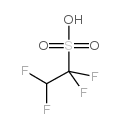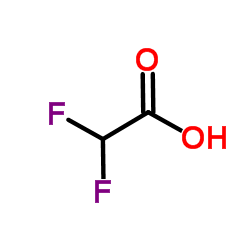464-14-2
| 中文名 | 1,1,2,2-四氟乙基磺酸 |
|---|---|
| 英文名 | 1,1,2,2-tetrafluoroethanesulfonic acid |
| 中文别名 | 四氟乙烷磺酸 |
| 英文别名 |
Tetrafluoroethanesulfonic acid
Ethanesulfonic acid,1,1,2,2-tetrafluoro TFESA 1,1,2,2-tetrafluoroethanesulphonic acid tetrafluoroethanesulphonic acid 1,1,2,2-Tetrafluor-aethansulfonsaeure 1,1,2,2-tetrafluoro-ethanesulfonic acid |
| 密度 | 1.7 |
|---|---|
| 沸点 | 250ºC |
| 分子式 | C2H2F4O3S |
| 分子量 | 182.09400 |
| 精确质量 | 181.96600 |
| PSA | 62.75000 |
| LogP | 1.81290 |
| 折射率 | n20/D 1.354 |
|
Section1. IDENTIFICATION OF THE SUBSTANCE/MIXTURE Product identifiers Product name: 1,1,2,2-Tetrafluoroethanesulfonic acid CAS-No.: 464-14-2 Relevant identified uses of the substance or mixture and uses advised against Identified uses: Laboratory chemicals, Manufacture of substances Section2. HAZARDS IDENTIFICATION Classification of the substance or mixture Classification according to Regulation (EC) No 1272/2008 [EU-GHS/CLP] Acute toxicity, Dermal (Category 4) Acute toxicity, Oral (Category 4) Skin corrosion (Category 1A) Classification according to EU Directives 67/548/EEC or 1999/45/EC Harmful in contact with skin and if swallowed. Causes severe burns. Label elements Labelling according Regulation (EC) No 1272/2008 [CLP] Pictogram Signal wordDanger Hazard statement(s) H302Harmful if swallowed. H312Harmful in contact with skin. H314Causes severe skin burns and eye damage. Precautionary statement(s) P280Wear protective gloves/ protective clothing/ eye protection/ face protection. P305 + P351 + P338IF IN EYES: Rinse cautiously with water for several minutes. Remove contact lenses, if present and easy to do. Continue rinsing. P310Immediately call a POISON CENTER or doctor/ physician. Supplemental Hazardnone Statements According to European Directive 67/548/EEC as amended. Hazard symbol(s) R-phrase(s) R21/22Harmful in contact with skin and if swallowed. R35Causes severe burns. S-phrase(s) S26In case of contact with eyes, rinse immediately with plenty of water and seek medical advice. S36/37/39Wear suitable protective clothing, gloves and eye/face protection. S45In case of accident or if you feel unwell, seek medical advice immediately (show the label where possible). Other hazards - none Section3. COMPOSITION/INFORMATION ON INGREDIENTS Substances Synonyms: TFESA Formula: C2H2F4O3S Molecular Weight: 182,09 g/mol ComponentConcentration 1,1,2,2-Tetrafluoroethanesulfonic acid CAS-No.464-14-2- Section4. FIRST AID MEASURES Description of first aid measures General advice Consult a physician. Show this safety data sheet to the doctor in attendance. If inhaled If breathed in, move person into fresh air. If not breathing, give artificial respiration. Consult a physician. In case of skin contact Take off contaminated clothing and shoes immediately. Wash off with soap and plenty of water. Consult a physician. In case of eye contact Rinse thoroughly with plenty of water for at least 15 minutes and consult a physician. If swallowed Do NOT induce vomiting. Never give anything by mouth to an unconscious person. Rinse mouth with water. Consult a physician. Most important symptoms and effects, both acute and delayed Material is extremely destructive to tissue of the mucous membranes and upper respiratory tract, eyes, and skin., spasm, inflammation and edema of the larynx, spasm, inflammation and edema of the bronchi, pneumonitis, pulmonary edema, burning sensation, Cough, wheezing, laryngitis, Shortness of breath, Headache, Nausea Indication of any immediate medical attention and special treatment needed no data available Section5. FIREFIGHTING MEASURES Extinguishing media Suitable extinguishing media Use water spray, alcohol-resistant foam, dry chemical or carbon dioxide. Special hazards arising from the substance or mixture Carbon oxides, Sulphur oxides, Hydrogen fluoride Advice for firefighters Wear self contained breathing apparatus for fire fighting if necessary. Further information no data available Section6. ACCIDENTAL RELEASE MEASURES Personal precautions, protective equipment and emergency procedures Use personal protective equipment. Avoid breathing vapors, mist or gas. Ensure adequate ventilation. Evacuate personnel to safe areas. Environmental precautions Do not let product enter drains. Methods and materials for containment and cleaning up Soak up with inert absorbent material and dispose of as hazardous waste. Keep in suitable, closed containers for disposal. Reference to other sections For disposal see section 13. Section7. HANDLING AND STORAGE Precautions for safe handling Avoid contact with skin and eyes. Avoid inhalation of vapour or mist. Normal measures for preventive fire protection. Conditions for safe storage, including any incompatibilities Store in cool place. Keep container tightly closed in a dry and well-ventilated place. Containers which are opened must be carefully resealed and kept upright to prevent leakage. Store under inert gas. Specific end use(s) no data available Section8. EXPOSURE CONTROLS/PERSONAL PROTECTION Control parameters Components with workplace control parameters Exposure controls Appropriate engineering controls Handle in accordance with good industrial hygiene and safety practice. Wash hands before breaks and at the end of workday. Personal protective equipment Eye/face protection Tightly fitting safety goggles. Faceshield (8-inch minimum). Use equipment for eye protection tested and approved under appropriate government standards such as NIOSH (US) or EN 166(EU). Skin protection Handle with gloves. Gloves must be inspected prior to use. Use proper glove removal technique (without touching glove's outer surface) to avoid skin contact with this product. Dispose of contaminated gloves after use in accordance with applicable laws and good laboratory practices. Wash and dry hands. The selected protective gloves have to satisfy the specifications of EU Directive 89/686/EEC and the standard EN 374 derived from it. Body Protection Complete suit protecting against chemicals, The type of protective equipment must be selected according to the concentration and amount of the dangerous substance at the specific workplace. Respiratory protection Where risk assessment shows air-purifying respirators are appropriate use a full-face respirator with multi-purpose combination (US) or type ABEK (EN 14387) respirator cartridges as a backup to engineering controls. If the respirator is the sole means of protection, use a full-face supplied air respirator. Use respirators and components tested and approved under appropriate government standards such as NIOSH (US) or CEN (EU). Section9. PHYSICAL AND CHEMICAL PROPERTIES Information on basic physical and chemical properties a) AppearanceForm: liquid Colour: yellow b) Odourno data available c) Odour Thresholdno data available d) pHno data available e) Melting point/freezingno data available point f) Initial boiling point and 210 - 211 °C at 1.013 hPa boiling range g) Flash pointno data available h) Evaporation rateno data available i) Flammability (solid, gas) no data available j) Upper/lowerno data available flammability or explosive limits k) Vapour pressure0,08 hPa at 25 °C 5 hPa at 82 °C l) Vapour densityno data available m) Relative density1,747 g/cm3 at 25 °C n) Water solubilityno data available o) Partition coefficient: n- no data available octanol/water p) Auto-ignitionno data available temperature q) Decompositionno data available temperature r) Viscosityno data available s) Explosive propertiesno data available t) Oxidizing propertiesno data available Other safety information no data available Section10. STABILITY AND REACTIVITY Reactivity no data available Chemical stability no data available Possibility of hazardous reactions no data available Conditions to avoid no data available Incompatible materials Strong oxidizing agentsStrong oxidizing agents, Water, Bases, Strong reducing agents Hazardous decomposition products Other decomposition products - no data available Section11. TOXICOLOGICAL INFORMATION Information on toxicological effects Acute toxicity no data available Skin corrosion/irritation no data available Serious eye damage/eye irritation no data available Respiratory or skin sensitization no data available Germ cell mutagenicity no data available Carcinogenicity IARC:No component of this product present at levels greater than or equal to 0.1% is identified as probable, possible or confirmed human carcinogen by IARC. Reproductive toxicity no data available Specific target organ toxicity - single exposure no data available Specific target organ toxicity - repeated exposure no data available Aspiration hazard no data available Potential health effects Inhalation May be harmful if inhaled. Material is extremely destructive to the tissue of the mucous membranes and upper respiratory tract. IngestionHarmful if swallowed. Causes burns. SkinHarmful if absorbed through skin. Causes skin burns. Eyes Causes eye burns. Signs and Symptoms of Exposure Material is extremely destructive to tissue of the mucous membranes and upper respiratory tract, eyes, and skin., spasm, inflammation and edema of the larynx, spasm, inflammation and edema of the bronchi, pneumonitis, pulmonary edema, burning sensation, Cough, wheezing, laryngitis, Shortness of breath, Headache, Nausea Additional Information RTECS: Not available Section12. ECOLOGICAL INFORMATION Toxicity no data available Persistence and degradability no data available Bioaccumulative potential no data available Mobility in soil no data available Results of PBT and vPvB assessment no data available Other adverse effects no data available Section13. DISPOSAL CONSIDERATIONS Waste treatment methods Product Offer surplus and non-recyclable solutions to a licensed disposal company. Contact a licensed professional waste disposal service to dispose of this material. Contaminated packaging Dispose of as unused product. Section14. TRANSPORT INFORMATION UN number ADR/RID: 3265IMDG: 3265IATA: 3265 UN proper shipping name ADR/RID: CORROSIVE LIQUID, ACIDIC, ORGANIC, N.O.S. (1,1,2,2-Tetrafluoroethanesulfonic acid) IMDG: CORROSIVE LIQUID, ACIDIC, ORGANIC, N.O.S. (1,1,2,2-Tetrafluoroethanesulfonic acid) IATA:Corrosive liquid, acidic, organic, n.o.s. (1,1,2,2-Tetrafluoroethanesulfonic acid) Transport hazard class(es) ADR/RID: 8IMDG: 8IATA: 8 Packaging group ADR/RID: IIMDG: IIATA: I Environmental hazards ADR/RID: noIMDG Marine Pollutant: noIATA: no Special precautions for user no data available SECTION 15 - REGULATORY INFORMATION N/A SECTION 16 - ADDITIONAL INFORMATION N/A |
| 危害码 (欧洲) | C: Corrosive; |
|---|---|
| 风险声明 (欧洲) | 21/22-35 |
| 安全声明 (欧洲) | 26-36/37/39-45 |
| 危险品运输编码 | UN 3265 8/PG 1 |
| 海关编码 | 2904909090 |
|
~87% 
464-14-2 |
| 文献:Harmer, Mark Andrew; Junk, Christopher P. Patent: US2007/100181 A1, 2007 ; Location in patent: Page/Page column 7 ; Title/Abstract Full Text Show Details Harmer, Mark Andrew; Junk, Christopher P.; Vickery, Jemma Patent: US2007/100184 A1, 2007 ; Location in patent: Page/Page column 7 ; |
|
~% 
464-14-2 |
| 文献:SRF LIMITED; IYENGAR, Sarathy; KUMARASWAMY, Radha; PHILIPHS, Mariano Patrick; GANESHAN, Vardaraj; SAXENA, Rahul; ANAND, Rajdeep Patent: WO2014/20614 A2, 2014 ; Location in patent: Page/Page column 4; 5; 6 ; |
|
~% 
464-14-2 |
| 文献:Coffman et al. Journal of Organic Chemistry, 1949 , vol. 14, p. 751 Full Text Show Details du Pont de Nemours and Co. Patent: US2403207 , 1943 ; |
| 上游产品 1 | |
|---|---|
| 下游产品 0 | |
| 海关编码 | 2904909090 |
|---|---|
| 中文概述 | 2904909090 其他烃的磺化、硝化、亚硝化衍生物(不论是否卤化). 增值税率:17.0% 退税率:9.0% 监管条件:无 最惠国关税:5.5% 普通关税:30.0% |
| 申报要素 | 品名, 成分含量, 用途 |
| Summary | HS:2904909090 sulphonated, nitrated or nitrosated derivatives of hydrocarbons, whether or not halogenated VAT:17.0% Tax rebate rate:9.0% Supervision conditions:none MFN tariff:5.5% General tariff:30.0% |




